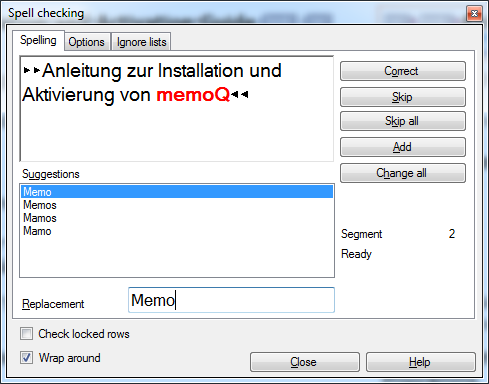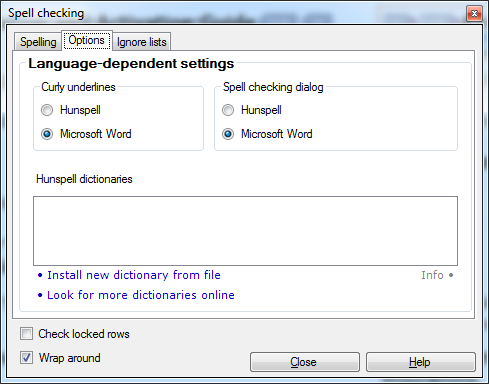|
Everyone makes typos (typing mistakes) sometimes. memoQ's spell checking feature allows you to find misspelled words, and comes up with suggestions to correct the words. memoQ uses either the spell checker installed with Microsoft® Office™ or an alternative (and preferred) open-source spell checker, Hunspell. Although the spell checker tries to look for all spelling mistakes, it is not able to find them all. If you have MS Office installed and the language pack (see MS Word Help for more info) for spell checking, you can choose whether to use MS Office or Hunspell for spell checking. Copyright Notice for Hunspell How to beginOn the Translation ribbon tab, choose Spell check, or press F7. UseWhen you invoke the spell checker, it reads through the segments of the active document, from the cursor position till the end of the document. The Spell checking dialog consists of three tabs: Spelling, Options and Ignore lists. Spelling tab This tab allows you to go through the segments of the active document, looking for spelling errors. •Upper list view: This list view indicates the actual spelling mistake found in one of the segments of the active document. •Suggestions list view: This list view indicates the suggested words of the active spell checker, for replacing the actual spelling mistake found in one of the segments of the active document with. •Segment: This field indicates the number of the segment in which the actual spelling mistake is. •Suggestions: Use this pane to select a suggestion offered by the spelling checker according to the dictionary selected. •Replacement: Use this field to enter the right form of the word spotted as a spelling mistake. Buttons: •Correct: Click this button to replace the original word with the selected automatic suggestion of the spell checker or the replacement word, once. •Skip: Click this button to not consider the actual word as misspelled, and to go on looking for other spelling mistakes. •Skip all: Click this button to not consider the same word as misspelled throughout the document. •Change all: Click this button to replace the original word with the selected automatic suggestion of the spell checker or the replacement word the same way throughout the document. •Add: Click this button to add a word to the ignore list. You can export ignore lists as Word dictionary. To do this, go to the Resource console > Ignore lists. Choose an ignore list, then click the Export to Word link.
Check locked rows check box: Check this check box to spell check locked rows. If a typo is found in the locked rows, memoQ stops. When you click Correct, you have an option to unlock the row and make the correction. Wrap around check box: Check this check box to continue spell check when the document end is reached. The check continues at the beginning of the document to the segment where you started the spell check. Important: MS Word does not support logographical languages and languages that do not use a delimiter character. Spell checking of Japanese, Chinese, Korean, Vietnamese and Thai is not supported. If your text contains single-byte words such as English words, these words will not be recognized by the spell checker. Options tab
This tab allows you to select the spelling method for the current target language, and to configure MS Word or Hunspell for that language. •Checking as you type section: •Microsoft Word: Click this radio button to look for spelling errors as you type using Microsoft Word. Microsoft Word 2000 SR-2 or newer must be installed on your computer to use this feature. If a language is not installed, you get no spelling errors underlined. •Hunspell: Click this radio button to look for spelling errors as you type using Hunspell. This is the default setting. Spelling through the Spell checking dialog section: •Microsoft Word: Click this radio button to look for spelling errors when you invoke the Spell checking dialog from the Translations menu, then choose Spelling..., or press F7 using Microsoft Word. Microsoft Word 2000 SR-2 or newer must be installed on your computer to use this feature. If a language is not installed, you get no spelling errors underlined. •Hunspell: Click this radio button to look for spelling errors when you invoke the Spell checking dialog from the Translations menu, then choose Spelling..., or press F7 using Hunspell. This is the default setting. Note: memoQ uses the following folder to store application-wide language-specific spelling options (i.e. whether MS Word or Hunspell is to be used for spell checking): •Hunspell dictionaries: This list view shows the available Hunspell dictionaries for the current language. •Install new dictionary from file: Click this command to install new Hunspell dictionary files. Note: You can install two kinds of dictionary files. Spelling archives, which consist of two files (e.g. es_ES.aff and es_ES.dic) and dictionary packages (e.g. de_DE-pack.zip) which contain zip archives, all having names starting with the same main language (e.g. de_AT.zip, de_CH.zip) and including the same kind of files (e.g. de_AT.aff and de_AT.dic, de_CH.aff and de_CH.dic). Note: memoQ uses the following folder to store Hunspell dictionaries: •Look for more dictionaries online: Click this button to look for dictionaries other than the ones listed in the Installed dictionaries for current language list view. The Download Hunspell dictionaries dialog appears. It has the following options: •Host: This field displays the URL of the ftp server where you can freely download Hunspell dictionaries from. •Check: Click this button to check the specified URL for downloadable dictionaries. •Remote directory: This field displays the path within the ftp server where you can find Hunspell dictionaries. •Dictionaries for current language: Use this list view to select the dictionaries you wish to download. •Download checked items: Click this button to download the dictionaries you selected in the Dictionaries for current language list view. •Cancel: Click this button to close the dialog without downloading any dictionaries. Ignore lists tab
This tab allows you to manage the words which should be ignored during spell checking. memoQ performs spell checking on a word-by-word basis. Words, for spelling, are defined as a sequence of non-whitespace characters, surrounded by whitespace or segment boundart. Before asking the spell check engine, memoQ first looks up the word in the ignore lists. If the word is found in any of these, it is considered to be OK, and the speller itself is not invoked. Lookup in the ingore lists, however, is smart: If the current word is in upper case (first or mixed or all capitals), but the same word only occurs in the list in lower case, that is accepted. If the current word has a trailing period, but a word (upper or lower case, as above) is in the list without a period, that is accepted. The reverse is not true: "etc." in the list will not make "etc " in the text acceptable. •Language: the target language of the open document is displayed here. •Ignore lists: This list shows all ignore lists used in the project. Ignore lists are light resources, and they can also be managed in the Settings pane of Project home, or the Ignore lists pane in the Resource console. •In the current project, add new words to: If you use multiple ignore lists in your project, you need to select one where you will add new words. (You add a new word to the ignore list by clicking Add in the Spelling tab of the Spelling dialog.) Use this drop-down list to choose that ignore list. Buttons: •New: Click this button to create a new ignore list. •Delete: Click this button to remove the selected ignore list from the list. •Edit: Click this button to edit the selected ignore list. The Edit ignore list dialog appears. NavigationClick Close to close the dialog.
See also: |


